The goat milk replacer market is valued at USD 4,620.0 million in 2025 and is projected to reach USD 8,328.9 million by 2035, rising at a 6.1% CAGR, with growth unfolding steadily rather than sharply. The shift is driven by healthcare systems that are becoming more nutrition-focused, pediatric-specialized, and sensitive to digestive tolerance variations. As hospitals, pediatric clinics, nutrition centers, and healthcare facilities add more specialized feeding systems and clinical protocols, the tolerance for feeding complications drops. Goat milk replacers appeal here because they improve digestibility reliably, enhance nutritional absorption consistently, and integrate well into existing feeding architectures without requiring redesign of nutrition protocols or clinical layouts.
The whole milk-based category, representing about 28% of demand, remains the workhorse segment due to its widespread fit in infant formula applications, pediatric feeding systems, clinical nutrition programs, and healthcare facilities. On the demand side, infant formula accounts for roughly 45% of total market consumption because health outcomes, digestive tolerance optimization, and nutritional enhancement pressures are highest in these environments.
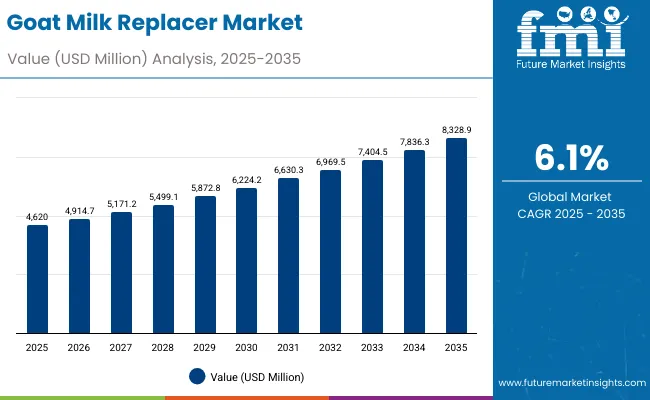
Goat Milk Replacer Market Key Takeaways
| Metric | Value |
|---|---|
| Market Value (2025) | USD 4,620.0 million |
| Market Forecast Value (2035) | USD 8,328.9 million |
| Forecast CAGR (2025 to 2035) | 6.1% |
Geographically, the market is led by UK (6.7% CAGR) and India (6.5% CAGR), supported by healthcare expansion, pediatric nutrition development, and government healthcare policy incentives. China (6.3%) and USA (5.8%) sustain growth through healthcare modernization and specialized nutrition systems, while France (5.2%), and Brazil (2.6%) grow through incremental healthcare adoption rather than system transformation. Competition remains moderately consolidated, with Meyenberg Goat Milk Products, Hoegger Supply Company, and SavenciaFromage & Dairy competing through specialized formulations, faster clinical validation, and application-specific support near healthcare hubs.
The science behind goat milk's nutritional advantages reveals why goat milk replacers have become essential alternatives in modern nutrition. Goat milk proteins demonstrate superior digestibility compared to conventional dairy alternatives, with smaller fat globules and unique protein structures that reduce allergenic reactions while maintaining nutritional density. The composition includes higher levels of medium-chain fatty acids and bioactive compounds that support infant development and adult digestive health. Clinical studies indicate that goat milk-based formulations show reduced inflammatory responses in sensitive individuals while providing comparable nutritional profiles to traditional dairy products.
The evolution of goat milk replacer technology mirrors the increasing sophistication of modern nutritional demands, progressing from basic powder formulations to complex liquid concentrates and ready-to-feed solutions capable of meeting diverse dietary requirements. Advanced processing techniques utilize specialized drying methods and protein isolation technologies that preserve bioactive compounds while achieving extended shelf stability. These systems incorporate sophisticated quality control and nutritional enhancement that continuously monitor protein content, vitamin levels, and mineral composition to maintain optimal nutritional parameters regardless of source variations or processing conditions.
Between 2025 and 2030, the goat milk replacer market is projected to expand from USD 4,620.0 million to USD 6,224.2 million, resulting in a value increase of USD 1,604.2 million, which represents 43.3% of the total forecast growth for the decade. This phase of development will be shaped by rising demand for specialized infant nutrition and alternative protein sources, product innovation in plant-based formulations and organic applications, as well as expanding integration with clinical nutrition and pediatric healthcare applications. Companies are establishing competitive positions through investment in advanced processing technologies, nutritional enhancement systems, and strategic market expansion across infant formula, clinical nutrition, and animal feed applications.
From 2030 to 2035, the market is forecast to grow from USD 6,224.2 million to USD 8,328.9 million, adding another USD 2,104.7 million, which constitutes 56.7% of the overall ten-year expansion. This period is expected to be characterized by the expansion of specialized nutritional applications, including advanced infant formula systems and next-generation clinical solutions tailored for specific dietary requirements, strategic collaborations between goat milk replacer manufacturers and healthcare companies, and an enhanced focus on organic certification standards and specialized processing protocols. The growing emphasis on pediatric nutrition and clinical applications will drive demand for comprehensive goat milk replacer solutions across diverse healthcare applications.
The goat milk replacer market grows by enabling healthcare providers and nutrition companies to optimize feeding programs while accessing specialized nutritional solutions without substantial in-house formulation infrastructure investment.
Healthcare companies and nutrition operators face mounting pressure to develop advanced feeding systems and specialized nutritional capabilities while managing complex safety requirements, with high-quality goat milk replacers typically providing 40-60% better digestibility compared to conventional alternatives, making advanced goat milk technologies essential for competitive healthcare positioning. The healthcare industry's need for specialized infant nutrition and application-specific feeding capabilities creates demand for comprehensive goat milk replacer solutions that can provide superior nutritional value, maintain consistent quality standards, and ensure reliable performance without compromising safety or nutritional effectiveness.
Government initiatives promoting infant health and specialized nutrition drive adoption in pediatric healthcare, clinical nutrition, and veterinary applications, where nutritional quality has a direct impact on health outcomes and long-term developmental effectiveness. However, supply chain constraints during large-scale production processes and the expertise requirements for advanced formulation integration may limit accessibility among smaller healthcare companies and developing regions with limited technical infrastructure for specialized nutrition systems.
The market is segmented by source type, form, application, end use, sales channel, functionality, and region. By source type, the market is divided into whole milk-based, skim milk-based, whey-based, and plant-based (soy, coconut, others). Based on form, the market is categorized into powder, liquid concentrate, and ready-to-feed liquid. By application, the market includes kids/toddlers, infant formula, adult nutrition, clinical nutrition, and animal feed (calves, lambs, piglets). By end use, the market is segmented into human nutrition (pediatric, geriatric, general health) and veterinary/animal nutrition (commercial livestock, companion animals).
By sales channel, the market covers supermarkets/hypermarkets, specialty stores, pharmacies/drugstores, online retail, veterinary clinics, and B2B (feed distributors, institutional buyers). By functionality, the market includes lactose-free, probiotic-fortified, high-protein, organic, A2 milk protein containing, and gluten-free variants. Regionally, the market is divided into North America, Europe, East Asia, South Asia & Pacific, Latin America, and Middle East & Africa.
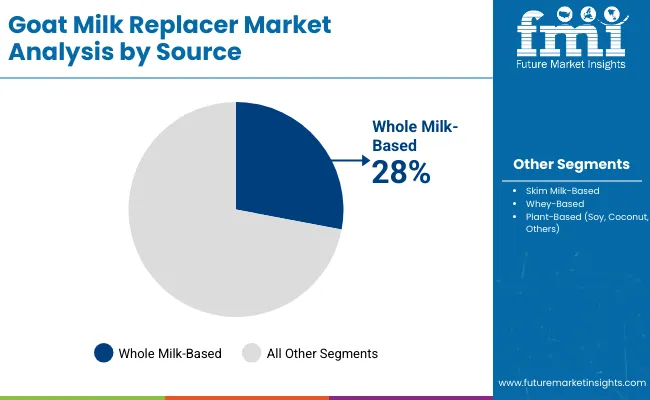
The whole milk-based segment represents the dominant force in the goat milk replacer market, capturing approximately 28.0% of total market share in 2025. This established source category encompasses solutions featuring complete nutritional profiles and comprehensive protein applications, including high-quality nutritional properties and enhanced digestibility characteristics that enable superior healthcare benefits and nutritional outcomes across all feeding applications. The whole milk-based segment's market leadership stems from its proven nutritional capabilities, with solutions capable of addressing diverse dietary requirements while maintaining consistent quality standards and digestibility effectiveness across all healthcare environments.
The whey-based segment maintains a substantial 27.0% market share, serving applications that require specialized protein processing with enhanced digestibility properties for pediatric healthcare and clinical applications. These solutions offer advanced nutritional capabilities for complex feeding processes while providing sufficient nutritional characteristics to meet healthcare and clinical operational demands. The skim milk-based segment accounts for approximately 25.0% of the market, while plant-based alternatives represent 20.0%, serving specialized applications requiring specific dietary properties or customized nutritional configurations.
Key source type advantages driving the whole milk-based segment include:
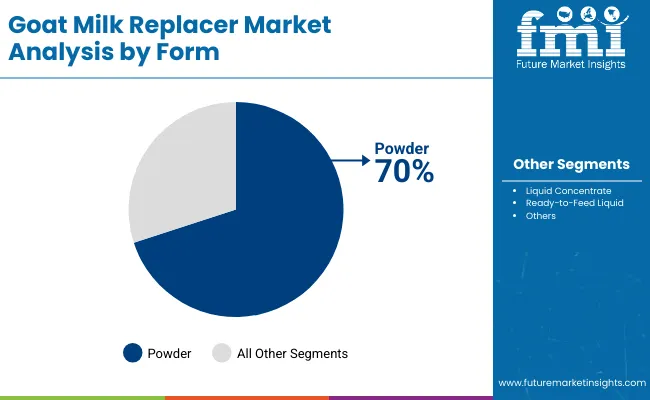
Powder applications dominate the goat milk replacer market with approximately 70.0% market share in 2025, reflecting the critical role of powder formulations in supporting specialized feeding requirements and nutritional performance worldwide. The powder segment's market leadership is reinforced by increasing healthcare trends, storage convenience requirements, and rising needs for extended shelf-life capabilities in feeding applications across developed and emerging markets.
The liquid concentrate segment represents the second-largest form category, capturing 15.0% market share through specialized requirements for ready-mix applications, clinical feeding processes, and healthcare facility applications. This segment benefits from growing healthcare integration demand that requires specific preparation requirements, quality compliance standards, and performance optimization protocols in medical markets.
The ready-to-feed liquid segment accounts for 15.0% market share, serving diverse healthcare and specialty applications across various feeding sectors.
Key market dynamics supporting form growth include:
The market is driven by three concrete demand factors tied to healthcare outcomes. First, advanced infant nutrition development and specialized feeding solutions create increasing demand for high-quality goat milk replacer systems, with nutritional enhancement of 15-25% annually in major healthcare applications worldwide, requiring comprehensive feeding infrastructure. Second, government initiatives promoting infant health and specialized nutrition drive increased adoption of alternative milk systems, with many countries implementing healthcare development programs and regulatory frameworks for nutritional advancement by 2030. Third, technological advancements in protein processing and clinical applications enable more efficient and effective feeding solutions that improve health outcomes while reducing operational costs and preparation complexity.
Market restraints include complex formulation requirements and validation costs for specialized feeding platforms that can challenge market participants in developing compliant nutritional capabilities, particularly in regions where regulatory pathways for alternative nutrition technologies remain evolving and uncertain. Technical complexity of specialized protein processing systems and quality requirements pose another significant challenge, as goat milk replacers demand sophisticated formulation methods and safety controls, potentially affecting production costs and operational efficiency. Supply chain constraints from specialized sourcing systems across different applications create additional operational challenges for manufacturers, demanding ongoing investment in supply development and optimization programs.
Key trends indicate accelerated adoption in South Asia & Pacific markets, particularly India and China, where healthcare expansion and nutrition modernization drive comprehensive goat milk replacer adoption. Technology integration trends toward specialized protein systems with enhanced nutritional characteristics, advanced clinical applications, and integrated feeding solutions enable effective healthcare approaches that optimize nutritional efficiency and minimize health risks. However, the market thesis could face disruption if significant advances in synthetic nutrition technologies or major changes in feeding practices reduce reliance on traditional goat milk replacer applications.
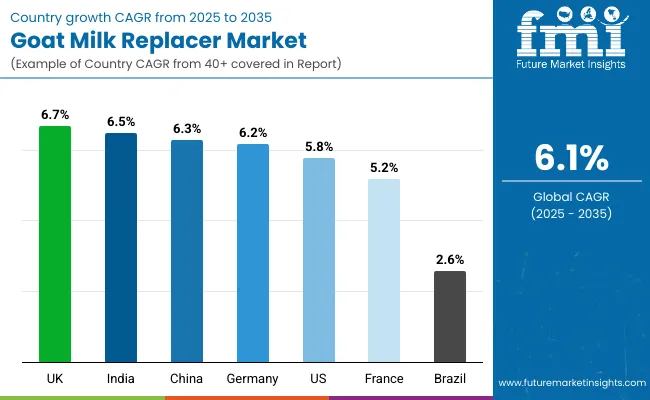
| Countries | CAGR (%) |
|---|---|
| UK | 6.7 |
| India | 6.5 |
| China | 6.3 |
| Germany | 6. 2 |
| USA | 5.8 |
| France | 5.2 |
| Brazil | 2.6 |
The global goat milk replacer market is expanding steadily, with UK leading at a 6.7% CAGR through 2035, driven by healthcare growth, government nutrition initiatives, and advanced pediatric feeding platforms. India follows at 6.5%, supported by healthcare modernization, large-scale nutrition programs, and clinical development initiatives. China record 6.3%, reflecting established landscapes with growing integration in infant nutrition and healthcare applications. USA advances at 5.8%, leveraging pediatric operations and specialized feeding capabilities. France records 5.2%, focusing on healthcare integration, while Brazil grows at 2.6%, emphasizing feeding precision and healthcare excellence.
UK demonstrates the strongest growth potential in the goat milk replacer market with a CAGR of 6.7% through 2035. The country's leadership position stems from healthcare sector expansion, government-backed nutrition initiatives, and comprehensive infant feeding regulations driving the adoption of advanced goat milk replacer solutions.
Growth is concentrated in major healthcare and nutrition centers, including London, Manchester, Birmingham, and Edinburgh, where pediatric healthcare companies and clinical nutrition firms are implementing advanced feeding systems for enhanced care capabilities and operational efficiency. Distribution channels through healthcare suppliers and nutrition providers expand deployment across pediatric projects and feeding development initiatives. The country's Department of Health provides policy support for nutrition technology modernization, including comprehensive feeding capability development.
Key market factors:
In major healthcare and nutrition centers including Mumbai, Delhi, Bangalore, and Hyderabad, the adoption of comprehensive goat milk replacer solutions is accelerating across pediatric projects and healthcare development initiatives, driven by nutrition scaling and government healthcare programs. The market demonstrates strong growth momentum with a CAGR of 6.5% through 2035, linked to comprehensive healthcare modernization and increasing focus on infant nutrition solutions.
Indian companies are implementing advanced goat milk replacer systems and feeding platforms to enhance care performance while meeting growing demand in expanding pediatric and clinical nutrition healthcare sectors. The country's healthcare development initiatives create continued demand for feeding equipment, while increasing emphasis on innovation drives adoption of advanced nutrition systems.
Key development areas:
China's market expansion is driven by diverse healthcare demand, including pediatric nutrition healthcare development in major cities and comprehensive clinical projects across multiple regions. The country demonstrates strong growth potential with a CAGR of 6.3% through 2035, supported by national healthcare programs and industry-level nutrition development initiatives.
Chinese companies face implementation challenges related to system complexity and scaling requirements, requiring strategic development approaches and support from specialized feeding equipment partners. However, growing healthcare demands and advanced nutrition requirements create compelling business cases for goat milk replacer adoption, particularly in pediatric areas where advanced feeding control has a direct impact on operational success and competitive positioning.
Market characteristics:
The Germany market leads in advanced nutrition innovation based on integration with healthcare systems and specialized feeding technologies for enhanced care performance. The country shows strong potential with a CAGR of 6.2% through 2035, driven by the modernization of existing healthcare infrastructure and the expansion of advanced nutrition facilities in major medical areas, including Bavaria, Baden-Württemberg, North Rhine-Westphalia, and Lower Saxony.
German companies are adopting intelligent goat milk replacer systems for care improvement and efficiency enhancement, particularly in regions with advanced healthcare requirements and medical applications demanding comprehensive technology upgrades. Technology deployment channels through established medical institutions and healthcare operators expand coverage across care facilities and innovation-focused applications.
Leading market segments:

In New York, Los Angeles, Chicago, and other major cities, healthcare facilities are implementing comprehensive goat milk replacer solutions to modernize existing medical infrastructure and improve nutrition capabilities, with documented case studies showing an improvement in operational timelines through advanced feeding system integration. The market shows strong growth potential with a CAGR of 5.8% through 2035, with the USA commanding USD 878.8 million in 2025 and projected to reach USD 1,534.8 million by 2035.
American companies are adopting intelligent feeding and nutrition platforms to enhance healthcare reliability while maintaining standards demanded by the pediatric and clinical nutrition industries. The country's established healthcare infrastructure creates continued demand for feeding system development and modernization solutions that integrate with existing medical systems.
Market development factors:
France’s goat milk replacer sector exhibits a mature, technology-driven growth trajectory, advancing at a CAGR of 5.2% through 2035. The growth is reinforced by the nation’s emphasis on healthcare integration, where advanced feeding systems are increasingly synchronized with medical nutrition programs and clinical infrastructure. This integration aligns with France’s ongoing healthcare modernization projects, prioritizing nutritional precision and patient-specific care. The adoption of goat milk replacers in neonatal and geriatric nutrition programs underscores the country’s commitment to evidence-based nutritional therapies and improved healthcare outcomes.
Collaborations between global nutrition technology providers and domestic healthcare networks are expanding the ecosystem for medical nutrition innovation. The French government’s strategic initiatives supporting hospital modernization and sustainable clinical nutrition further strengthen adoption, as public and private healthcare providers emphasize safety, digestibility, and therapeutic potential. With growing R&D investments and the rise of digital monitoring solutions in feeding systems, France continues to position itself as a European leader in nutrition-oriented healthcare advancement.
Brazil’s goat milk replacer industry is expanding at a CAGR of 2.6% through 2035, reflecting an emerging market shaped by gradual healthcare infrastructure evolution and nutritional program expansion. The Brazilian healthcare sector is steadily adopting goat milk replacer solutions, particularly in pediatric and maternal health segments, as part of efforts to reduce malnutrition and improve early-life nutrition standards. Growth is mainly concentrated in urban centers such as São Paulo, Rio de Janeiro, and Brasília, where hospitals and nutrition clinics are better equipped to integrate specialized feeding products.
The government’s increasing investment in public health and nutrition awareness campaigns, coupled with partnerships between domestic producers and global suppliers, is fostering gradual market development. Brazil’s focus on accessibility and affordability of medical nutrition products is also encouraging small-scale adoption across regional healthcare facilities. Although infrastructure and import dependency pose challenges, the country’s advancing nutritional education programs and emphasis on pediatric wellness are expected to create long-term opportunities for goat milk replacer integration in clinical and homecare applications.
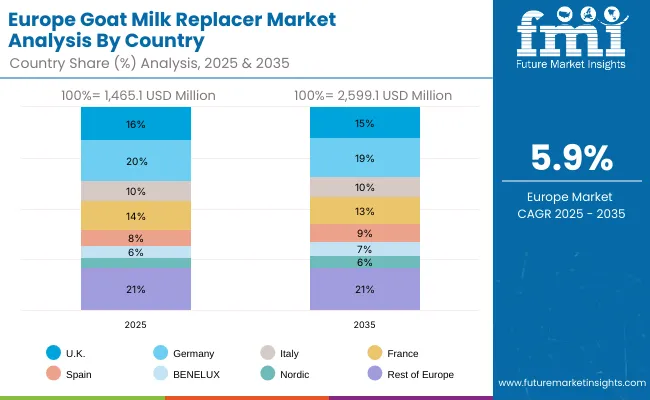
The goat milk replacer market in Europe is projected to grow from USD 1,465.1 million in 2025 to USD 2,599.1 million by 2035, registering a CAGR of 5.9% over the forecast period. Germany is expected to maintain its leadership position with a 20.0% market share in 2025, projected to reach USD 494.0 million by 2035, supported by its extensive healthcare infrastructure, advanced nutrition facilities, and comprehensive medical networks serving major European markets.
United Kingdom follows with a 16.0% share in 2025, projected to reach USD 390.0 million by 2035, driven by comprehensive pediatric nutrition programs in major healthcare regions implementing advanced feeding systems. France holds a 14.0% share in 2025, expected to reach USD 338.0 million by 2035 through the ongoing development of medical facilities and healthcare networks. Italy commands a 10.0% share projected to reach USD 260.0 million, while Spain accounts for 8.0% expected to reach USD 234.0 million in 2035. BENELUX holds a 6.0% share growing to USD 182.0 million, Nordic countries account for 5.0% reaching USD 130.0 million, while the Rest of Europe region is anticipated to maintain momentum at 21.0%, reaching USD 546.0 million by 2035.
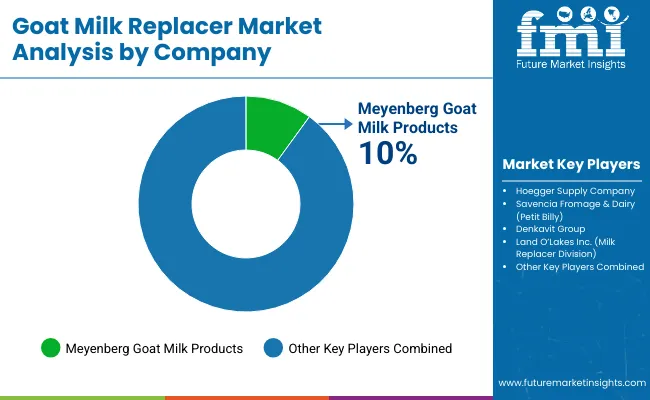
The goat milk replacer market is moderately concentrated, where the top three companies control roughly 25-35% of global market share through established nutrition portfolios and extensive healthcare relationships. Competition centers on nutritional quality, product safety, and technical expertise rather than price competition alone.
Market leaders include Meyenberg Goat Milk Products that accounts for nearly 10% market share. Hoegger Supply Company, and SavenciaFromage & Dairy, which maintain competitive advantages through comprehensive nutrition portfolios, advanced processing capabilities, and deep expertise in the pediatric nutrition and healthcare sectors, creating high switching costs for customers. These companies leverage established healthcare relationships and ongoing development partnerships to defend market positions while expanding into adjacent clinical nutrition and veterinary applications.
Challengers encompass Denkavit Group and Land O'Lakes Inc., which compete through specialized feeding technologies and strong regional presence in key healthcare markets. Healthcare specialists, including various regional players, focus on specific nutrition applications or vertical markets, offering differentiated capabilities in specialized systems, clinical applications, and application-specific feeding.
Regional players and emerging nutrition companies create competitive pressure through innovative feeding approaches and rapid development capabilities, particularly in high-growth markets including India and China, where local presence provides advantages in cost optimization and regulatory compliance. Market dynamics favor companies that combine advanced nutrition technologies with comprehensive healthcare services that address the complete feeding lifecycle from formulation through ongoing performance assurance and technical support.
| Items | Values |
|---|---|
| Quantitative Units (2025) | USD 4,620.0 Million |
| Source Type | Whole Milk-Based, Skim Milk-Based, Whey-Based, Plant-Based (Soy, Coconut, Others) |
| Form | Powder, Liquid Concentrate, Ready-to-Feed Liquid |
| Application | Kids/Toddlers, Infant Formula, Adult Nutrition, Clinical Nutrition, Animal Feed (Calves, Lambs, Piglets) |
| End Use | Human Nutrition (Pediatric, Geriatric, General Health), Veterinary/Animal Nutrition (Commercial Livestock, Companion Animals) |
| Sales Channel | Supermarkets/Hypermarkets, Specialty Stores, Pharmacies/Drugstores, Online Retail, Veterinary Clinics, B2B (Feed Distributors, Institutional Buyers) |
| Functionality | Lactose-Free, Probiotic-Fortified, High-Protein, Organic, A2 Milk Protein Containing, Gluten-Free |
| Regions Covered | North America, Europe, East Asia, South Asia & Pacific, Latin America, Middle East & Africa |
| Countries Covered | India, China, Germany, UK, USA, France, Brazil, Japan, South Korea, and 40+ countries |
| Key Companies Profiled | Meyenberg Goat Milk Products, Hoegger Supply Company, Savencia Fromage & Dairy, Denkavit Group, Land O'Lakes Inc. |
| Additional Attributes | Dollar sales by source type and form categories, regional adoption trends across Europe, South Asia & Pacific, and North America, competitive landscape with equipment providers and healthcare companies, nutrition facility requirements and specifications, integration with clinical initiatives and healthcare platforms. |
The goat milk replacer market is valued at USD 4,620.0 million in 2025.
The market is projected to reach USD 8,328.9 million by 2035.
The market is expected to grow at a CAGR of 6.1% from 2025 to 2035.
Whole milk-based replacers lead the market with approximately 28% share in 2025.
Powder formulations hold the largest share at around 70% in 2025.






Our Research Products

The "Full Research Suite" delivers actionable market intel, deep dives on markets or technologies, so clients act faster, cut risk, and unlock growth.

The Leaderboard benchmarks and ranks top vendors, classifying them as Established Leaders, Leading Challengers, or Disruptors & Challengers.

Locates where complements amplify value and substitutes erode it, forecasting net impact by horizon

We deliver granular, decision-grade intel: market sizing, 5-year forecasts, pricing, adoption, usage, revenue, and operational KPIs—plus competitor tracking, regulation, and value chains—across 60 countries broadly.

Spot the shifts before they hit your P&L. We track inflection points, adoption curves, pricing moves, and ecosystem plays to show where demand is heading, why it is changing, and what to do next across high-growth markets and disruptive tech

Real-time reads of user behavior. We track shifting priorities, perceptions of today’s and next-gen services, and provider experience, then pace how fast tech moves from trial to adoption, blending buyer, consumer, and channel inputs with social signals (#WhySwitch, #UX).

Partner with our analyst team to build a custom report designed around your business priorities. From analysing market trends to assessing competitors or crafting bespoke datasets, we tailor insights to your needs.
Supplier Intelligence
Discovery & Profiling
Capacity & Footprint
Performance & Risk
Compliance & Governance
Commercial Readiness
Who Supplies Whom
Scorecards & Shortlists
Playbooks & Docs
Category Intelligence
Definition & Scope
Demand & Use Cases
Cost Drivers
Market Structure
Supply Chain Map
Trade & Policy
Operating Norms
Deliverables
Buyer Intelligence
Account Basics
Spend & Scope
Procurement Model
Vendor Requirements
Terms & Policies
Entry Strategy
Pain Points & Triggers
Outputs
Pricing Analysis
Benchmarks
Trends
Should-Cost
Indexation
Landed Cost
Commercial Terms
Deliverables
Brand Analysis
Positioning & Value Prop
Share & Presence
Customer Evidence
Go-to-Market
Digital & Reputation
Compliance & Trust
KPIs & Gaps
Outputs
Full Research Suite comprises of:
Market outlook & trends analysis
Interviews & case studies
Strategic recommendations
Vendor profiles & capabilities analysis
5-year forecasts
8 regions and 60+ country-level data splits
Market segment data splits
12 months of continuous data updates
DELIVERED AS:
PDF EXCEL ONLINE
Goat Handling Equipment Market Size and Share Forecast Outlook 2025 to 2035
Goat Creep Feeder Market Analysis by Material, Operation, Application and Region: A Forecast for 2025 and 2035
Goat Milk Products Market Size and Share Forecast Outlook 2025 to 2035
Automatic Goat Waterer Market Size and Share Forecast Outlook 2025 to 2035
Sheep and Goat Equipment Market Size and Share Forecast Outlook 2025 to 2035
Milk Froth Thermometer Market Size and Share Forecast Outlook 2025 to 2035
Milk Carton Market Size and Share Forecast Outlook 2025 to 2035
Milking Automation Market Size and Share Forecast Outlook 2025 to 2035
Milking Robots Market Size and Share Forecast Outlook 2025 to 2035
Milk Packaging Market Size and Share Forecast Outlook 2025 to 2035
Milk Clarifier Market Size and Share Forecast Outlook 2025 to 2035
Milk Homogenizer Machine Market Size and Share Forecast Outlook 2025 to 2035
Milk Pasteurization Machines Market Size and Share Forecast Outlook 2025 to 2035
Milk Sterilizer Machine Market Size and Share Forecast Outlook 2025 to 2035
Milk Powder Packaging Market Size and Share Forecast Outlook 2025 to 2035
Milk Powder Packaging Machines Market Size and Share Forecast Outlook 2025 to 2035
Milk Protein Market - Size, Share, and Forecast 2025 to 2035
Milk Ingredients Market Analysis - Size, Share, and Forecast Outlook 2025 to 2035
Milk Mineral Concentrate Market Trends-Demand, Innovations & Forecast 2025 to 2035
Milk Thistle Market Analysis by Form, Distribution Channel and Region through 2035

Thank you!
You will receive an email from our Business Development Manager. Please be sure to check your SPAM/JUNK folder too.
Chat With
MaRIA